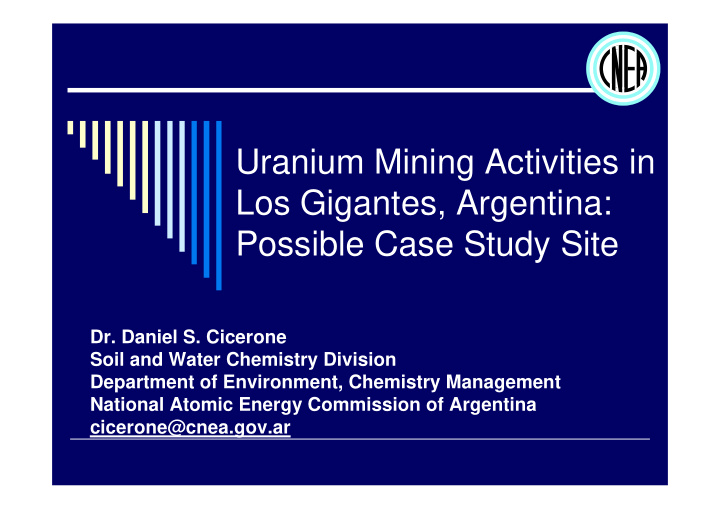



Uranium Mining Activities in Los Gigantes, Argentina: Possible Case Study Site Dr. Daniel S. Cicerone Soil and Water Chemistry Division Department of Environment, Chemistry Management National Atomic Energy Commission of Argentina cicerone@cnea.gov.ar
PRAMU: Project of Environmental Restitution of Uranium Mining Activities •Article 41. National Constitution of Argentina. •National Law 24804. Nuclear Energy •National Law 25018. Management of Radioactive Waste. Article 10 (J) management of waste coming from uranium mining activities. Article 11, environmental restitution of affected sites. •National and Provincial regulations related to environment, mining and management of water resources.
THE SITE � The uranium mining facility of Los Gigantes is located in Sierra Grande (30 km of the city of Villa Carlos Paz, and remained operational till 1990. � 1957 Detection of uranium minerals � 1970 Detailed Prospecting Studies � 1979 Awarding of the mining production to a private company � 206 tn of concentrated U produced
THE SITE � 2500000 tn of mineral processed (0,15 °/ oo U 3 O 8 tcf, 0,239 °/ oo U 3 O 8 mean law, 0,123 °/ oo U 3 O 8 for maginal mineral � Open Quarry (500 m length,10 m high) � Grinding and classification of mineral by crushing to 4 inches � Land owner: private � Inside Provincial Water Reserve of Achala
Industrial Plant H 2 SO 4 Open Open Radiometric Radiometric Radiometric Radiometric Radiometric Radiometric Radiometric Radiometric Radimetric Radimetric Grinding Grinding Grinding Grinding Grinding Grinding Grinding Leaching Leaching Leaching Leaching Leaching Tanks Tanks Tanks Tanks Open Pit Open Pit Open Pit Open Pit Open Pit Open Pit Open Pit Open Pit Open Pit Quarry Quarry Tunnel Tunnel Tunnel Tunnel Tunnel Tunnel Tunnel Tunnel Tunnel Tunnel Classification Classification Classification Classification Classification Classification Classification Units Units Units Units Units U 3 O 8 U 3 O 8 U 3 O 8 U 3 O 8 CaOH 2 Ionic Ionic Ionic Exchange Exchange Exchange NH 4 NO 3 Resins Resins Resins T, NH 3 Saturated Ionic Yellow Solid Electric Dry Yellow Centrifuge Centrifuge Exchange U 2 O 7 (NH 4 ) 2 Oven Cake Resin
WASTE INVENTORY Dams Sector Camp Sector Tanks Sector Mineral Tailing Sector l Marginales Sector Leaching Ponds 2.500.000 tn mineral tails. 1.000.000 tn waste rock Quarry Sector 600.000 tn marginales. Waste Rock 100.000 m 3 precipitation mud Sector 100.000 m 3 liquid effluents
Morphology � High Mountain plain associated to a tectonic step called La Mesada
Geomorphology � Non eroded positive landscape � Intact granitic basement � Fluvial Sediment desposition: San Roque Dam
Hydrology - Climate � Surface and subsurface water chemistry determined by the crystalline basement � Water level: 2 phases (dry season from may to september; rain season from october to april).
Geology � Igneous-metamorphic basement supporting sediments of different ages � Plutonic rock composed of potassium feldspar, kaolin, quartz, sodium plagioclase, biotite, augite, apatite and zircon with high uranium contents , rutile � Granite age: ~329-331 million years � Two faults contribute to secondary permeabilility
Mineralization � Main minerals: � Autunite Ca(UO 2 ) 2 (PO 4 ) 2 10-12 H 2 O triclinic � Metaautunite Ca(UO 2 ) 2 (PO 4 ) 2 2-6 H 2 O triclinic � Secondary: � Ca(UO 2 ) 2 (SiO 3 ) 2 (OH) 2 5 H 2 O monoclinic � Ca(UO 2 ) 4 (PO 4 ) 2 (OH) 4 7 H2O rhombic
Hydrogeology � No massive accumulation of meteoric water (positive landscape and crystalline basement) � Faults are responsible of percolation and define recharge zones � Low content of dissolved solids (15 µ S cm -1 )
Geological Risk � Seismicity 1
SURFACE WATER MONITORING PROGRAM � Compliance of National Law 24051 (Decree 831/93). � Compliance of Provincial Regulations (Decree 415/99 Córdoba)
SUBSURFACE WATER MONITORING PROGRAM � Compliance of National Law 24051 (Decree 831/93). � Compliance of Provincial Regulations (Decree 415/99 Córdoba)
RADIOLOGICAL MONITORING PROGRAM � Compliance of Norm AR 10.1.1 � Activity 222 Rn in air � Equivalent dose rate � Surface contamination of materials, tools, clothing, etc. 222 Rn Monitoring Network
Points of Equivalent Dose Rate Assessment
DATA BASE � Includes: � Land use � Socioeconomical Aspects � Inventory and physicochemical characterization of the solid and liquid residues (tails, marginales, waste rock, precipitation muds, ponds) � Measurements of emanation, Rn in air and gamma radiation (tails, marginales, waste rock, precipitation muds, ponds)
DATA BASE � Includes: � Physical Studies of soils (humidity, consistency, permeability, compactation, texture) � Gamma Radiation base line measurements � Water Cycle (10 years of rain, evaporation)
Data Base � Includes � PhysicoChemical parameters of surface and subsurface waters � Flow volume � Regulations (discharges, allowed values, reference values for aquatic life protection � Main Impacts � Mitigation Actions
Thank you!
Recommend
More recommend